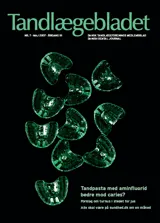Aminfluoridtandpastas mulige virkningsmekanismer og effekt på caries. En oversigt
På højeste evidensniveau har det vist sig at fluortandpasta har cariesreducerende effekt. Den cariesreducerende effekt er dosisafhængig; 1.500 ppm fluortandpasta har bedre effekt end 1.000 ppm fluortandpasta. Noget tyder på at fluorformlen i tandpastaen også spiller en rolle. Fluorid i tandpasta optræder ioniseret som natriumfluorid (NaF) eller monofluorfosfat (MFP) eller organisk fx i aminfluoridholdig tandpasta (AmF). Da AmF-tandpasta introduceres på det danske marked i løbet af 2007, er formålet med denne oversigtsartikel at undersøge om der er dokumentation for tandpastaens effekt på caries og cariesrelaterede variabler. AmF-tandpastaen i form af Olaflur opfører sig som et tensid. Det bevirker at fluorid ledes direkte hen på tanden. pH i AmF-tandpastaer er lavere end i de traditionelle tandpastaer. Det kan dokumenteres at fluoridkoncentrationen i tandens omgivelser er højere efter brug af AmF-tandpastaen end ved brug af NaF- eller MFP-tandpasta. Potentielt burde AmF-tandpasta derfor have en større cariesreducerende effekt end NaF- og MFP-tandpastaer, når fluoridkoncentrationerne i tandpastaerne i øvrigt er ens. Selvom en enkelt randomiseret klinisk undersøgelse støtter denne antagelse, er konklusionen at der ikke er tilstrækkelig med dokumentation til at sige at AmF-tandpasta har bedre cariesreduktion end de traditionelle tandpastaer som anvendes i Danmark.
The possible action mechanisms and effects on caries of Amin fluoride toothpaste. A review: At the highest evidence level, fluoride toothpaste has proved to have a caries-reducing effect. The caries-reducing effect is dependent on the dose; 1,500 ppm fluoride toothpaste has a better effect than 1,000 ppm fluoride toothpaste. Some signs indicate that the fluoride formula of the toothpaste also plays an important role. Fluoride in toothpaste is either ionized as natrium fluoride (NaF) or monofluoridephos -phate (MFP) or it is organic, e.g. in amin fluoride toothpaste (AmF). As AmF toothpaste is going to be launched on the Danish market in 2007, the purpose of this review is to investigate whether there is evidence for the toothpaste’s effects on caries and caries-related variables. When AmF toothpaste is in the form of Olaflur it is acting like a tenside (active on surfaces). This means that the fluoride is led directly to the tooth surface. The pH in AmF toothpaste is lower than in traditional toothpaste. It is proved that the fluoride concentration in the environment of the tooth is higher after use of AmF toothpaste compared to use of NaF or MFP toothpaste. Hence, potentially AmF toothpaste should have a better caries-reducing effect than NaF and MFP toothpastes, provided that the fluoride concentrations are the same. Even though one randomized clinical study supports this theory, the conclusion is that the evidence for stating that AmF toothpaste has a better caries-reducing effect than traditional toothpaste used in Denmark is insufficient.


